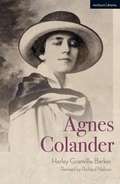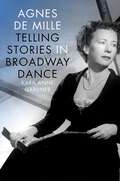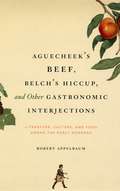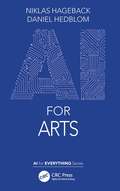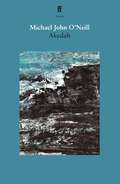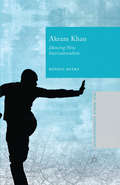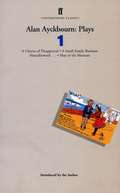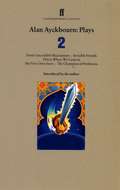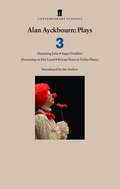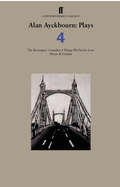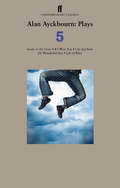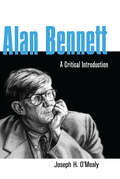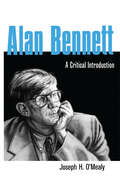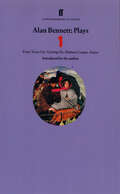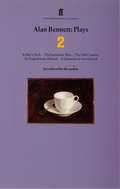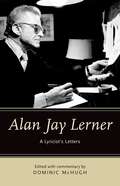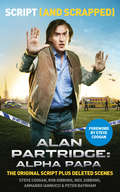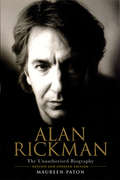- Table View
- List View
Agnes Colander (Modern Plays)
by Harley Granville BarkerWe should all have been taught more of life and less good mannersIt is three years since Agnes, an artist, left her unfaithful husband Henry. Now he writes to her in her Kensington studio begging to reunite, but Agnes married young; her innocence has gone and her ambition and independence is growing. As she travels from London to France, Agnes finds herself torn between Otho, a worldly Danish artist and Alec, an infatuated younger suitor, between a longing to paint and be an independent woman and a yearning to be loved.This witty and compelling exploration of love, sexual attraction and independence was written in 1900 and unearthed among Granville Barker's papers in the British Library a century later. Revised by playwright and librettist Richard Nelson this edition was published to coincide with the world premiere at the Theatre Royal Bath in Spring 2018.
Agnes de Mille: Telling Stories in Broadway Dance (Broadway Legacies)
by Kara Anne GardnerThis book explores the Broadway legacy of choreographer Agnes de Mille, from the 1940s through the 1960s. Six musicals are discussed in depth - Oklahoma!, One Touch of Venus, Bloomer Girl, Carousel, Brigadoon, and Allegro. Oklahoma!, Carousel, and Brigadoon were de Mille's most influential and lucrative Broadway works. The other three shows exemplify aspects of her legacy that have not been fully examined, including the impact of her ideas on some of the composers with whom she worked; her ability to incorporate a previously conceived work into the context of a Broadway show; and her trailblazing foray into the role of choreographer/director. Each chapter emphasizes de Mille's unique contributions to the original productions. Several themes emerge in looking closely at de Mille's Broadway repertoire. Character development remained at the heart of her theatrical work work. She often took minor characters, represented with minimal or no dialogue, and fleshed out their stories. These stories added a layer of meaning that resulted in more complex productions. Sometimes, de Mille's stories were different from the stories her collaborators wanted to tell, which caused many conflicts. Because her unique ideas often got woven into the fabric of her musicals, de Mille saw her choreography as an authorship. She felt she should be given the same rights as the librettist and the composer. De Mille's work as an activist is an aspect of her legacy that has largely been overlooked. She contributed to revisions in dance copyright law and was a founding member of the Stage Directors and Choreographers Society, a theatrical union that protects the rights of directors and choreographers. Her contention that choreographers are authors who have their own stories to tell offers a new way of understanding the Broadway musical.
Agnes de Mille: Telling Stories in Broadway Dance (Broadway Legacies)
by Kara Anne GardnerThis book explores the Broadway legacy of choreographer Agnes de Mille, from the 1940s through the 1960s. Six musicals are discussed in depth - Oklahoma!, One Touch of Venus, Bloomer Girl, Carousel, Brigadoon, and Allegro. Oklahoma!, Carousel, and Brigadoon were de Mille's most influential and lucrative Broadway works. The other three shows exemplify aspects of her legacy that have not been fully examined, including the impact of her ideas on some of the composers with whom she worked; her ability to incorporate a previously conceived work into the context of a Broadway show; and her trailblazing foray into the role of choreographer/director. Each chapter emphasizes de Mille's unique contributions to the original productions. Several themes emerge in looking closely at de Mille's Broadway repertoire. Character development remained at the heart of her theatrical work work. She often took minor characters, represented with minimal or no dialogue, and fleshed out their stories. These stories added a layer of meaning that resulted in more complex productions. Sometimes, de Mille's stories were different from the stories her collaborators wanted to tell, which caused many conflicts. Because her unique ideas often got woven into the fabric of her musicals, de Mille saw her choreography as an authorship. She felt she should be given the same rights as the librettist and the composer. De Mille's work as an activist is an aspect of her legacy that has largely been overlooked. She contributed to revisions in dance copyright law and was a founding member of the Stage Directors and Choreographers Society, a theatrical union that protects the rights of directors and choreographers. Her contention that choreographers are authors who have their own stories to tell offers a new way of understanding the Broadway musical.
Ágóta Kristóf: Collected Plays (Oberon Modern Playwrights)
by Ágóta Kristóf Bart SmetThe complete collection of Ágota Kristóf’s works for the stage, comprising of five full-length plays and four shorter works. The bulk of these plays predate her acclaimed trilogy of novels (The Notebook, The Proof, The Third Lie) and give a fascinating insight into the development of her unique style. The collection includes: John and Joe, The Lift Key, A Passing Rat, The Grey Hour or the Last Client, The Monster, The Road, The Epidemic, The Atonement and Line, the Time.
Aguecheek's Beef, Belch's Hiccup, and Other Gastronomic Interjections: Literature, Culture, and Food Among the Early Moderns (Chicago Series On Sexuality, History And Society)
by Robert AppelbaumWe didn’t always eat the way we do today, or think and feel about eating as we now do. But we can trace the roots of our own eating culture back to the culinary world of early modern Europe, which invented cutlery, haute cuisine, the weight-loss diet, and much else besides. Aguecheek’s Beef, Belch’s Hiccup tells the story of how early modern Europeans put food into words and words into food, and created an experience all their own. Named after characters in Shakespeare’s Twelfth Night, this lively study draws on sources ranging from cookbooks to comic novels, and examines both the highest ideals of culinary culture and its most grotesque, ridiculous and pathetic expressions. Robert Appelbaum paints a vivid picture of a world in which food was many things—from a symbol of prestige and sociability to a cause for religious and economic struggle—but always represented the primacy of materiality in life. Peppered with illustrations and a handful of recipes, Aguecheek’s Beef, Belch’s Hiccup will appeal to anyone interested in early modern literature or the history of food.
Aguecheek's Beef, Belch's Hiccup, and Other Gastronomic Interjections: Literature, Culture, and Food Among the Early Moderns
by Robert AppelbaumWe didn’t always eat the way we do today, or think and feel about eating as we now do. But we can trace the roots of our own eating culture back to the culinary world of early modern Europe, which invented cutlery, haute cuisine, the weight-loss diet, and much else besides. Aguecheek’s Beef, Belch’s Hiccup tells the story of how early modern Europeans put food into words and words into food, and created an experience all their own. Named after characters in Shakespeare’s Twelfth Night, this lively study draws on sources ranging from cookbooks to comic novels, and examines both the highest ideals of culinary culture and its most grotesque, ridiculous and pathetic expressions. Robert Appelbaum paints a vivid picture of a world in which food was many things—from a symbol of prestige and sociability to a cause for religious and economic struggle—but always represented the primacy of materiality in life. Peppered with illustrations and a handful of recipes, Aguecheek’s Beef, Belch’s Hiccup will appeal to anyone interested in early modern literature or the history of food.
Aguecheek's Beef, Belch's Hiccup, and Other Gastronomic Interjections: Literature, Culture, and Food Among the Early Moderns (The\chicago Ser. On Sexuality, History, And Society Ser.)
by Robert AppelbaumWe didn’t always eat the way we do today, or think and feel about eating as we now do. But we can trace the roots of our own eating culture back to the culinary world of early modern Europe, which invented cutlery, haute cuisine, the weight-loss diet, and much else besides. Aguecheek’s Beef, Belch’s Hiccup tells the story of how early modern Europeans put food into words and words into food, and created an experience all their own. Named after characters in Shakespeare’s Twelfth Night, this lively study draws on sources ranging from cookbooks to comic novels, and examines both the highest ideals of culinary culture and its most grotesque, ridiculous and pathetic expressions. Robert Appelbaum paints a vivid picture of a world in which food was many things—from a symbol of prestige and sociability to a cause for religious and economic struggle—but always represented the primacy of materiality in life. Peppered with illustrations and a handful of recipes, Aguecheek’s Beef, Belch’s Hiccup will appeal to anyone interested in early modern literature or the history of food.
AI for Arts (AI for Everything)
by Niklas Hageback Daniel HedblomAI for Arts is a book for anyone fascinated by the man–machine connection, an unstoppable evolution that is intertwining us with technology in an ever-greater degree, and where there is an increasing concern that it will be technology that comes out on top. Thus, presented here through perhaps its most esoteric form, namely art, this unfolding conundrum is brought to its apex. What is left of us humans if artificial intelligence also surpasses us when it comes to art? The articulation of an artificial intelligence art manifesto is long overdue, so hopefully this book can fill a gap that will have repercussions not only for aesthetic and philosophical considerations but possibly more so for the development of artificial intelligence.
AI for Arts (AI for Everything)
by Niklas Hageback Daniel HedblomAI for Arts is a book for anyone fascinated by the man–machine connection, an unstoppable evolution that is intertwining us with technology in an ever-greater degree, and where there is an increasing concern that it will be technology that comes out on top. Thus, presented here through perhaps its most esoteric form, namely art, this unfolding conundrum is brought to its apex. What is left of us humans if artificial intelligence also surpasses us when it comes to art? The articulation of an artificial intelligence art manifesto is long overdue, so hopefully this book can fill a gap that will have repercussions not only for aesthetic and philosophical considerations but possibly more so for the development of artificial intelligence.
Akedah
by Michael John O'NeillWe heal people. That's what we do here. We are a kinship.Gill has returned home to the north coast of Northern Ireland determined to speak to her younger sister Kelly for the first time in three years. There she is shocked to discover that Kelly has become a devout member of a rapidly expanding Christian community called Harvest. As Gill struggles to reconcile this Kelly with the Kelly she has been keeping safe in her mind, a noise is gathering at their periphery that refuses to go unheard any longer.Akedah won the Bruntwood Prize Original New VoiceAward in 2019. It premiered at Hampstead Theatre, London, in February 2023.
Akram Khan: Dancing New Interculturalism (New World Choreographies)
by Royona MitraThrough seven key case studies from Khan's oeuvre, this book demonstrates how Akram Khan's 'new interculturalism' is a challenge to the 1980s western 'intercultural theatre' project, as a more nuanced and embodied approach to representing Othernesses, from his own position of the Other.
Alan Ayckbourn: Time of My Life; Neighbourhood Watch; Arrivals and Departures; Hero’s Welcome; A Brief History of Women (Faber Drama Ser.)
by Alan AyckbournWith an Introduction by the author.'The prolific master of suburban mayhem has still got his mojo.' Evening StandardTime of My Life'One of Mr. Ayckbourn's most virtuosic experiments in postmodern narrative.' Wall Street JournalNeighbourhood Watch'Ayckbourn's tartly topical, pitch-black comedy, a startling evocation of the panic induced by nightmarish notions of "broken Britain"... An arresting, nastily comic cautionary tale.' The TimesArrivals and Departures'Ayckbourn's genius lies in his ability to write what you might call 'sad comedies,' uproariously funny farces that are at second glance deeply serious, at times despairing portraits of modern middle-class life and its discontents. On occasion, as in Arrivals & Departures, he puts the despair at centre stage, and what results is a play that at bottom can no longer be called a comedy at all.' Wall Street JournalHero's Welcome 'Alan Ayckbourn is the poet laureate of missed connections. In play after pensive, droll and acid play, Ayckbourn anatomizes how we fail to understand and trust our lovers and friends.' GuardianA Brief History of Women'As A Brief History of Women follows Spates at twenty year intervals through the next sixty years, it becomes progressively more funny, more tender, more Ayckbourn. Ayckbourn knows that moments of real connection between people are hard-won and hard to forget.' The Times
Alan Ayckbourn Plays 1
by Alan AyckbournThe first volume of Alan Ayckbourn's collected work contains his morality plays from the 1980s. It includes the plays A Chorus of Disapproval, A Small Family Business, Henceforward . . ., and Man of the Moment.
Alan Ayckbourn Plays 2: Ernie’s Incredible Illucinations; Invisible Friends; This is Where We Came In; My Very Own Story; The Champion of Paribanou
by Alan AyckbournA treat to read and a joy to perform, this second collection of Alan Ayckbourn's work is a cornucopia of some of his wonderfully inventive children's plays. From the story of the teenage Lucy in Invisible Friends who revives her childhood imaginary friend when things get difficult at home, onto the storytellers in My Very Own Story and This Is Where We Came In and, finally, to young Ernie who 'illucinates' all sorts of wild and weird happenings with astonishing results.
Alan Ayckbourn Plays 3: Haunting Julia; Sugar Daddies; Drowning on Dry Land; Private Fears in Public Places
by Alan AyckbournThis third volume of Alan Ayckbourn plays includes Haunting Julia, Sugar Daddies, Drowning on Dry Land and Private Fears in Public Places, with an introduction by the author.Haunting Julia'A play for today. It touches on the failures of education and parenting, on media pressure and overdoses. Kurt Cobain comes to mind. More universally, Haunting Julia mourns how in adolescence and adulthood, we do our loves wrong.' Financial TimesSugar Daddies'A timely warning about the dangers of role-playing and pretence . . . But the real fascination lies in watching Ayckbourn's own transformation from social observer to impassioned moralist.' GuardianDrowning on Dry Land'Ayckbourn at the top of his game.' Guardian'A coruscatingly acid and funny play.' The TimesPrivate Fears in Public Places'Ayckbourn's construction has a masterly clarity; his writing combines ruthless observation with mature tolerance. Nobody else writing today can create a sense of a complicated little world in 90 minutes, or make banal lives seem so unforgivably interesting. Listen: it's a master's voice.' Sunday Times
Alan Ayckbourn Plays 4
by Alan AyckbournThe Revengers' ComediesA hugely entertaining pitch that recalls the old movies to which it frequently pays homage - Strangers on a Train, Rebecca, Kind Hearts and Coronets - and expands after intermission to reveal an immensely disturbing vision of contemporary middle-class England poisoned by the rise of economic ruthlessness and the collapse of ethics. New York Times Things We Do for LoveLloyds Private Banking Playwright of the Year AwardOne of his best, his most shockingly and uproariously funny: a cruel and hilarious masterpiece of tragic comedy and comic tragedy. Sunday TimesHouse & GardenThe triumph of his ingenuity lies in the fact that you have to see both plays . . . A second time round, in whichever order you take them, characters will deepen, while those you know become the background. It is a superb Ayckbourn joke that a comedy about non-communication should depend on the sharpest communication skills. Sunday Times
Alan Ayckbourn Plays 5: Snake in the Grass; If I Were You; Life and Beth; My Wonderful Day; Life of Riley
by Alan AyckbournSnake in the GrassA terrific piece - brilliant, bizarre and yet totally believable . . . In fact, it's more than classic; it's close to the top of its class. Yorkshire Post If I Were YouA blissfully funny comedy that's also filled with sadness, a devilishly simple theatrical idea that spins out all kinds of complex truths about human nature. Daily Telegraph Life and BethA wise, humane, funny play about the inevitability of death and the continuity of life. GuardianMy Wonderful DayA transformation happens as magical as the most magnificent pantomime transformation anyone could ever imagine . . . the playwright dissolves the paraphernalia of our adult selves and uncovers that space inside each of us that is still the child we once were. ObserverLife of RileyAs perceptive as ever . . . Ayckbourn has once again achieved a satisfyingly rich, tragi-comic complexity. Daily Telegraph
Alan Bennett: A Critical Introduction (Studies in Modern Drama)
by Joseph O'MealyAlan Bennett is perhaps best known in the UK for the BBC production of his Talking Heads TV plays, while the rest of the world may recognize him for the film adaptation of his play, The Madness of King George. O'Mealy points out that Bennett is a social critic strongly influenced by Beckett and Swift, interested in depicting and analyzing the role playing of everyday life, a'la sociologist Ervin Goffman.
Alan Bennett: A Critical Introduction (Studies in Modern Drama)
by Joseph O'MealyAlan Bennett is perhaps best known in the UK for the BBC production of his Talking Heads TV plays, while the rest of the world may recognize him for the film adaptation of his play, The Madness of King George. O'Mealy points out that Bennett is a social critic strongly influenced by Beckett and Swift, interested in depicting and analyzing the role playing of everyday life, a'la sociologist Ervin Goffman.
Alan Bennett Plays 1: Forty Years On, Getting On, Habeas Corpus and Enjoy
by Alan BennettThis collection of Alan Bennett's work includes his first play and West End hit, Forty Years On, as well as Getting On, Habeus Corpus, and Enjoy.Forty Years On'Alan Bennett's most gloriously funny play ... a brilliant, youthful perception of a nation in decline, as seen through the eyes of a home-grown school play ... a classic.' Daily MailGetting OnWinner of the Evening Standard Best Comedy Award in 1971, Getting on is an account of a middle-aged Labour MP, so self-absorbed that he remains blind to the fact that his wife is having an affair with the handyman, his mother-in-law in dying, his son is getting ready to leave home, his best friend thinks him a fool and that to everyone who comes into contact with him he is a self-esteeming joke.Habeus Corpus'After two elegiac comedies about the decline of old England, Mr Bennett has now written a gorgeously vulgar but densely plotted facre that is a downright celebration of sex and the human body ... a combination of hurtling action with verbal brilliance.' GuardianEnjoyEnjoy uncannily foresaw the attitudes to English working-class life now enshrined in themeparks. 'The classic tug in Bennett between childhod Yorkshire and intellectual sophistication has never been better, or more daringly expressed.' Observer
Alan Bennett Plays 2: Kafka's Dick; Insurance Man; Old Country; Englishman Abroad; Question of Attribution
by Alan BennettThis second volume of plays by Alan Bennett includes his two Kafka plays, one an hilarious comedy, the other a profound and searching drama. Also included is An Englishman Abroad and A Question of Attribution. The fascination of these two plays lies in the way they question our accepted notions of treachery and, in different ways, make a sympathetic case for Guy Burgess and Anthony Blunt.
Alan Jay Lerner: A Lyricist's Letters
by Dominic McHughThe man behind "I Could Have Danced all Night" and "Almost Like Being in Love", lyricist Alan Jay Lerner (1918-1986) is widely regarded as one of the most important figures of the American musical stage. In penning the lyrics to some of the most well-known and beloved Broadway shows, including Brigadoon, Paint Your Wagon, My Fair Lady, and Camelot, Lerner worked and corresponded with some of the greatest luminaries of popular entertainment over a career which spanned four decades, from performers like Rex Harrison and Julie Andrews to composers like André Previn, Leonard Bernstein, Charles Strouse, Andrew Lloyd Webber, and especially Frederick Loewe. In this rich collection of correspondence, most of it published for the first time, author Dominic McHugh sheds new light on Lerner's working relationships with these legendary figures. McHugh's extensive commentary reveals Lerner's turbulent partnerships with Loewe and Lane, his affection for Harrison, and his reverence for Burton. Particular emphasis is placed on Lerner's aborted projects with composers like Richard Rodgers and Arthur Schwartz. Especially valuable is the correspondence from his final years, in which he worked on a movie version of The Merry Widow, a BBC TV series about musicals, and a musical version of My Man Godfrey, none of which came to fruition. The collection ends with a poignant final exchange between Lerner and Andrew Lloyd Webber, with whom he was to have written The Phantom of the Opera. Overall, this important and lively book reveals the highs and lows of the career of one of America's wittiest and most romantic lyricists.
Alan Jay Lerner: A Lyricist's Letters
by Dominic MchughThe man behind "I Could Have Danced all Night" and "Almost Like Being in Love", lyricist Alan Jay Lerner (1918-1986) is widely regarded as one of the most important figures of the American musical stage. In penning the lyrics to some of the most well-known and beloved Broadway shows, including Brigadoon, Paint Your Wagon, My Fair Lady, and Camelot, Lerner worked and corresponded with some of the greatest luminaries of popular entertainment over a career which spanned four decades, from performers like Rex Harrison and Julie Andrews to composers like André Previn, Leonard Bernstein, Charles Strouse, Andrew Lloyd Webber, and especially Frederick Loewe. In this rich collection of correspondence, most of it published for the first time, author Dominic McHugh sheds new light on Lerner's working relationships with these legendary figures. McHugh's extensive commentary reveals Lerner's turbulent partnerships with Loewe and Lane, his affection for Harrison, and his reverence for Burton. Particular emphasis is placed on Lerner's aborted projects with composers like Richard Rodgers and Arthur Schwartz. Especially valuable is the correspondence from his final years, in which he worked on a movie version of The Merry Widow, a BBC TV series about musicals, and a musical version of My Man Godfrey, none of which came to fruition. The collection ends with a poignant final exchange between Lerner and Andrew Lloyd Webber, with whom he was to have written The Phantom of the Opera. Overall, this important and lively book reveals the highs and lows of the career of one of America's wittiest and most romantic lyricists.
Alan Partridge (and Scrapped): The Script
by Steve Coogan Rob Gibbons Neil Gibbons Armando Iannucci Peter BaynhamThe official script for the box-office smash movie, featuring every ruddy word (and stage direction) of Alan’s seamless transformation from natural-born broadcaster into fully fledged and occasionally fully dressed hostage negotiator. Contains deleted scenes and an exclusive Foreword by Steve Coogan.
Alan Rickman: The Unauthorized Biography
by Maureen PatonIn this revised and updated biography, Maureen Paton encompasses the private, professional and political life of this most enigmatic, charismatic and intensely private of actors.
